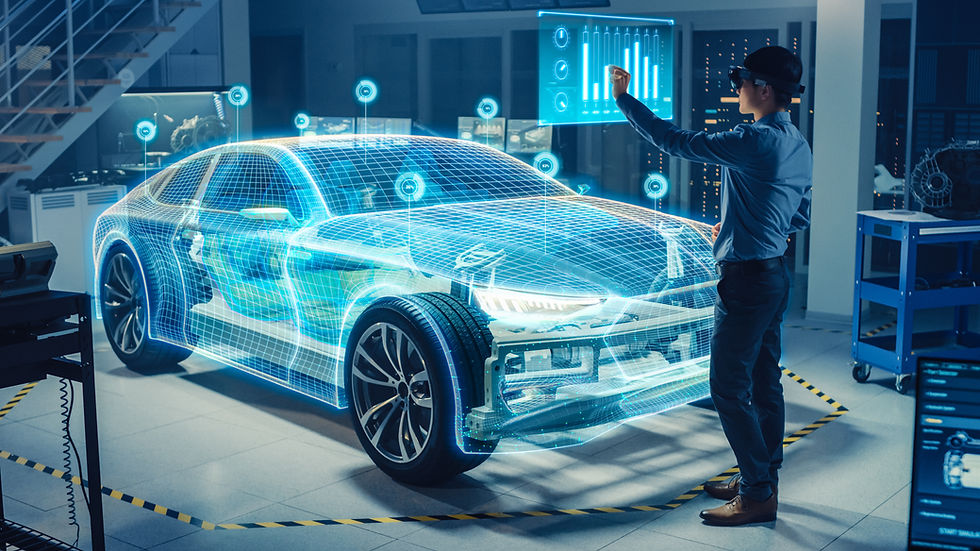Augmented Reality for Businesses
- Anant Acharya

- Dec 31, 2022
- 3 min read
Updated: May 11, 2023
What is Augmented Reality?
Augmented reality (AR) is a technology that allows users to see and interact with digital content in the context of the real world. It involves overlaying digital information or graphics on top of a live view of the physical world, often through the use of a device such as a smartphone or tablet.

AR can be used for a wide range of applications, including entertainment, education, training, and retail. For example, AR can be used to create immersive gaming experiences, to visualize products in a virtual showroom, or to provide real-tim
e information about a physical location.
AR is often distinguished from virtual reality (VR), which involves fully immersive digital environments that users can interact with in real time. While VR requires users to wear a headset or other specialized equipment, AR can be accessed through a device with a camera, such as a smartphone or tablet.
AR technology is constantly evolving, and there are many new and exciting applications being developed in a wide range of industries. Some examples of emerging AR technologies include AR glasses, AR contact lenses, and AR projection systems.
How can AR help businesses?
Augmented reality (AR) has the potential to revolutionize many industries by offering a new way for businesses to interact with customers and for individuals to access information and experiences. Some examples of how AR can be used in different industries include:
Retail: AR can be used in retail to enhance the shopping experience by allowing customers to virtually try on clothes, visualize products in their home, and access product information in real time.
Healthcare: AR can be used in healthcare to provide training and education, to visualize complex medical procedures, and to assist in diagnoses and treatments.
Manufacturing: AR can be used in manufacturing to improve efficiency and accuracy by providing real-time information and guidance to workers on the production floor.
Education: AR can be used in education to create immersive learning experiences and to make complex concepts more accessible to students.
Entertainment: AR can be used in entertain
ment to create immersive gaming experiences and to enhance live events such as concerts and sporting events.
Marketing: AR can be used in marketing to create engaging and interactive campaigns that help businesses stand out and attract customers.
Overall, AR has the potential to transform a wide range of industries by providing a new way for businesses and individuals to interact with and access information in the real world.
How can AR be applied in manufacturing industry?
There are several ways in which augmented reality (AR) can be used in manufacturing to improve efficiency, accuracy, and safety:
Training and education: AR can be used to provide interactive training and education to workers on the production floor, allowing them to learn new skills and procedures in a hands-on way.
Visualizing complex processes: AR can be used to visualize and explain complex manufacturing processes, making them easier to understand and follow.
Providing real-time information: AR can be used to provide workers with real-time information and guidance, such as step-by-step ins
tructions or alerts about potential issues.
Improving quality control: AR can be used to help workers identify and correct quality issues in real time, improving the overall quality of the finished product.
Enhancing safety: AR can be used to provide workers with safety information and alerts, helping to reduce the risk of accidents and injuries on the production floor.
Overall, AR has the potential to improve efficiency and accuracy in manufacturing by providing workers with the information and guidance they need to perform their tasks effectively. It can also help to enhance safety on the production floor by providing workers with access to important information and alerts in real time.
How can service industry apply AR in its business model?
Augmented reality (AR) has the potential to transform the service industry by providing a new way for businesses to interact with customers and for individuals to access information and experiences. Some examples of how AR can be used in the service industry include:
Customer service: AR can be used to provide customers with real-time information and guidance, such as product demonstrations or repair instructions.
Virtual showrooms: AR can be used to create virtual showrooms that allow customers to visualize products in their home or office before making a purchase.
Virtual try-ons: AR can be used to allow customers to virtually try on clothes or accessories, helping them make informed purchasing decisions.
Enhancing the customer experience: AR can be used to create immersive and interactive experiences that help businesses stand out and attract customers.
Providing real-time information: AR can be used to provide service industry workers with real-time information and guidance, such as step-by-step instructions or alerts about potential issues.
Overall, AR has the potential to improve the customer experience and enhance the efficiency of service industry businesses by providing real-time information and guidance to both customers and workers.
Marsbazaar.com is increasingly focusing on the use of augmented reality for manufacturing and service industries that are cost-effective and extremely value-adding. Contact us at cto@marsbazaar.com to find out more.



Comments